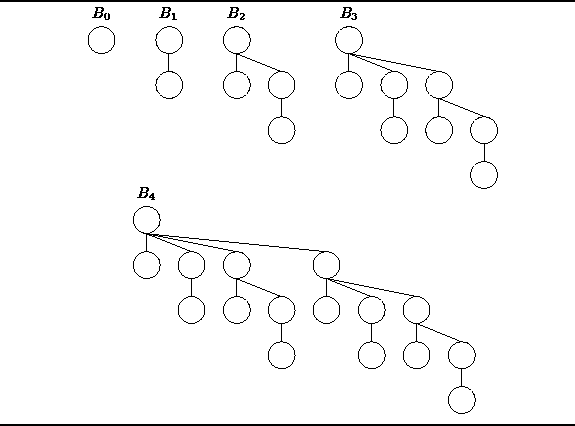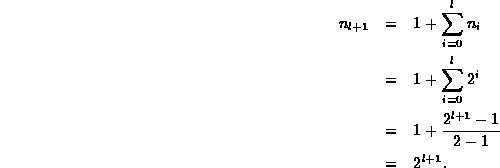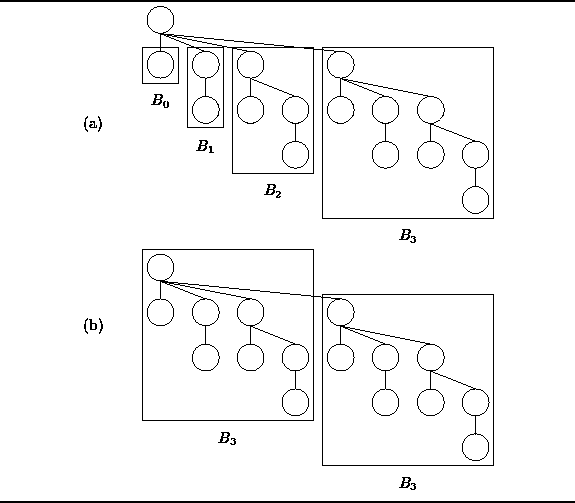- If k=0,
 .
I.e., the binomial tree of order zero consists of a single node, R.
.
I.e., the binomial tree of order zero consists of a single node, R. - If k>0,
 .
I.e., the binomial tree of order k>0 comprises the root R,
and k binomial subtrees,
.
I.e., the binomial tree of order k>0 comprises the root R,
and k binomial subtrees,  ,
,  , ...,
, ...,  .
.
A binomial tree is a general tree with a very special shape:
Definition (Binomial Tree) The binomial tree of orderwith root R is the tree
defined as follows
- If k=0,
. I.e., the binomial tree of order zero consists of a single node, R.
- If k>0,
. I.e., the binomial tree of order k>0 comprises the root R, and k binomial subtrees,
,
, ...,
.
Figure ![]() shows the first five binomial trees,
shows the first five binomial trees, ![]() -
- ![]() .
It follows directly from Definition
.
It follows directly from Definition ![]() that the root of
that the root of ![]() ,
the binomial tree of order k,
has degree k.
Since k may arbitrarily large,
so too can the degree of the root.
Furthermore, the root of a binomial tree has the largest fanout of
any of the nodes in that tree.
,
the binomial tree of order k,
has degree k.
Since k may arbitrarily large,
so too can the degree of the root.
Furthermore, the root of a binomial tree has the largest fanout of
any of the nodes in that tree.

Figure: Binomial Trees ![]() ,
, ![]() , ...,
, ..., ![]()
The number of nodes in a binomial tree of order k is a function of k:
Theorem The binomial tree of order k,, contains
nodes.
extbfProof (By induction).
Let ![]() be the number of nodes in
be the number of nodes in ![]() ,
a binomial tree of order k.
,
a binomial tree of order k.
Base Case
By definition, ![]() consists a single node.
Therefore
consists a single node.
Therefore ![]() .
.
Inductive Hypothesis
Assume that ![]() for
for ![]() , for some
, for some ![]() .
Consider the binomial tree of order l+1:
.
Consider the binomial tree of order l+1:
![]()
Therefore the number of nodes in ![]() is given by
is given by

Therefore, by induction on l, ![]() for all
for all ![]() .
.
It follows from Theorem ![]() that binomial trees only come
in sizes that are a power of two.
I.e.,
that binomial trees only come
in sizes that are a power of two.
I.e., ![]() .
Furthermore, for a given power of two,
there is exactly one shape of binomial tree.
.
Furthermore, for a given power of two,
there is exactly one shape of binomial tree.
Theorem The height of, the binomial tree of order k, is k.
extbfProof (By induction).
Let ![]() be the height of
be the height of ![]() ,
a binomial tree of order k.
,
a binomial tree of order k.
Base Case
By definition, ![]() consists a single node.
Therefore
consists a single node.
Therefore ![]() .
.
Inductive Hypothesis
Assume that ![]() for
for ![]() , for some
, for some ![]() .
Consider the binomial tree of order l+1:
.
Consider the binomial tree of order l+1:
![]()
Therefore the height ![]() is given by
is given by

Therefore, by induction on l, ![]() for all
for all ![]() .
.
Theorem ![]() tells us that the height of a binomial tree of order k
is k and Theorem
tells us that the height of a binomial tree of order k
is k and Theorem ![]() tells us that the number of nodes is
tells us that the number of nodes is ![]() .
Therefore, the height of
.
Therefore, the height of ![]() is exactly
is exactly ![]() .
.
Figure ![]() shows that there are two ways
to think about the construction of binomial trees.
The first way follows directly from the Definition
shows that there are two ways
to think about the construction of binomial trees.
The first way follows directly from the Definition ![]() .
I.e., binomial
.
I.e., binomial ![]() consists of a root node to which the k binomial trees
consists of a root node to which the k binomial trees
![]() ,
, ![]() , ...,
, ..., ![]() are attached
as shown in Figure
are attached
as shown in Figure ![]() (a).
(a).

Figure: Two Views of Binomial Tree ![]()
Alternatively, we can think of ![]() as being comprised of two binomial
trees of order k-1.
For example, Figure
as being comprised of two binomial
trees of order k-1.
For example, Figure ![]() (b) shows that
(b) shows that ![]() is made up of two instances of
is made up of two instances of ![]() .
In general, suppose we have two trees of order k-1,
say
.
In general, suppose we have two trees of order k-1,
say ![]() and
and ![]() ,
where
,
where ![]() .
Then we can construct a binomial tree of order k by combining
the trees to get
.
Then we can construct a binomial tree of order k by combining
the trees to get
![]()
Why do we call ![]() a binomial tree?
It is because the number of nodes at a given depth in the tree
is determined by the binomial coefficient.
And the binomial coefficient derives its name from the binomial theorem.
And the binomial theorem tells us how to compute the
a binomial tree?
It is because the number of nodes at a given depth in the tree
is determined by the binomial coefficient.
And the binomial coefficient derives its name from the binomial theorem.
And the binomial theorem tells us how to compute the ![]() power of
a binomial .
And a binomial is an expression which consists of two terms, such as x+y.
That is why it is called a binomial tree!
power of
a binomial .
And a binomial is an expression which consists of two terms, such as x+y.
That is why it is called a binomial tree!
Theorem (Binomial Theorem) Thepower of the binomial x+y for
is given by
extbfProof
The proof of the binomial theorem
is left as an exercise for the reader (Exercise ![]() ).
).![]()
The following theorem gives the expression for the number of nodes at a given depth in a binomial tree:
Theorem The number of nodes at level l in, the binomial tree of order k, where
, is given by the binomial coefficient
.
extbfProof (By induction).
Let ![]() be the number of nodes at level l in
be the number of nodes at level l in ![]() ,
a binomial tree of order k.
,
a binomial tree of order k.
Base Case
Since ![]() contains a single node,
there is only one level in the tree, l=0,
and exactly one node at that level.
Therefore,
contains a single node,
there is only one level in the tree, l=0,
and exactly one node at that level.
Therefore, ![]() .
.
Inductive Hypothesis
Assume that ![]() for
for ![]() , for some
, for some ![]() .
The binomial tree of order h+1 is composed of
two binomial trees of height h,
one attached under the root of the other.
Hence, the number of nodes at level l in
.
The binomial tree of order h+1 is composed of
two binomial trees of height h,
one attached under the root of the other.
Hence, the number of nodes at level l in ![]() is equal to the number of nodes at level l in
is equal to the number of nodes at level l in ![]() plus the number of nodes at level l-1 in
plus the number of nodes at level l-1 in ![]() :
:

Therefore by induction on h, ![]() .
.